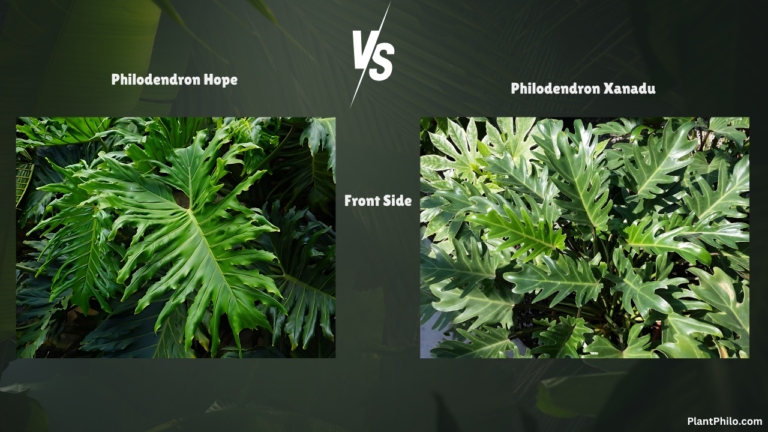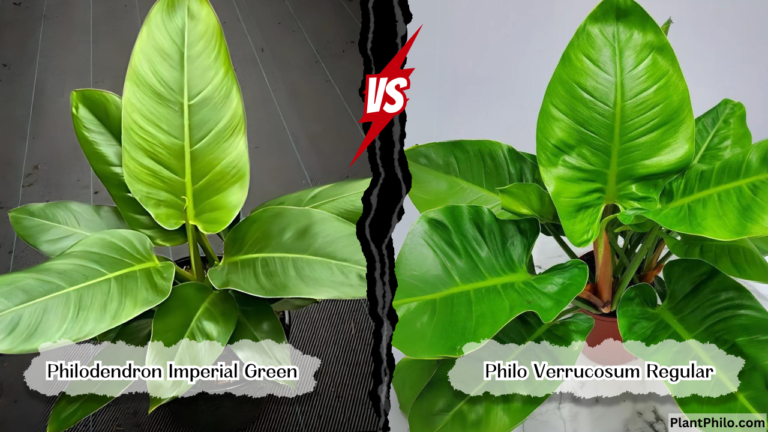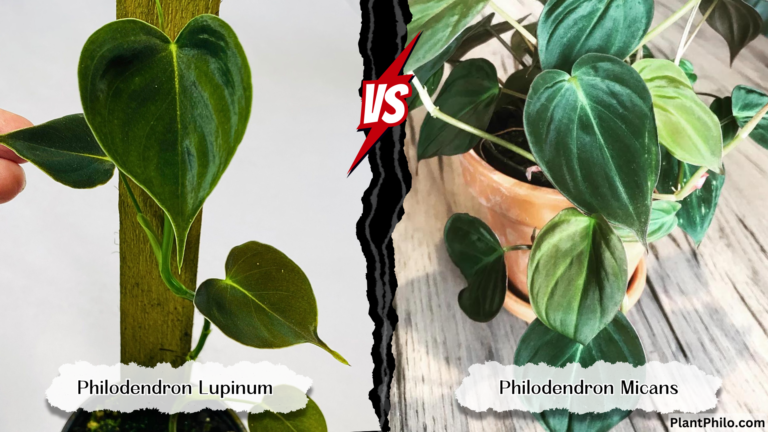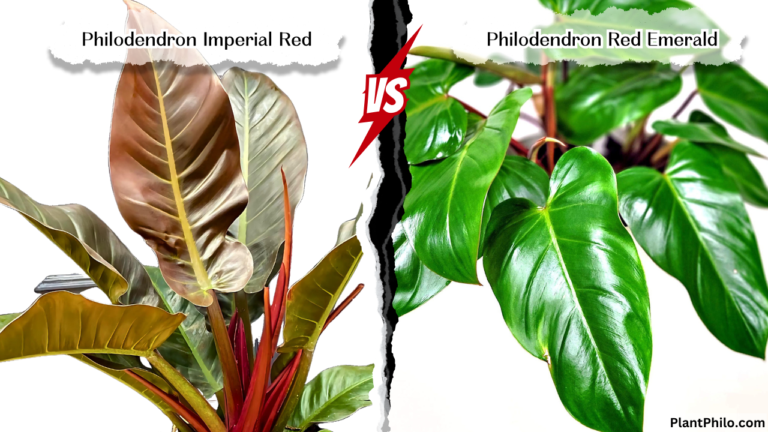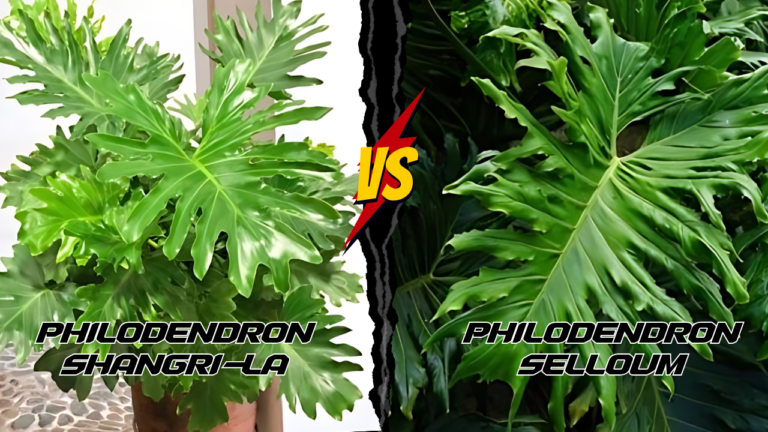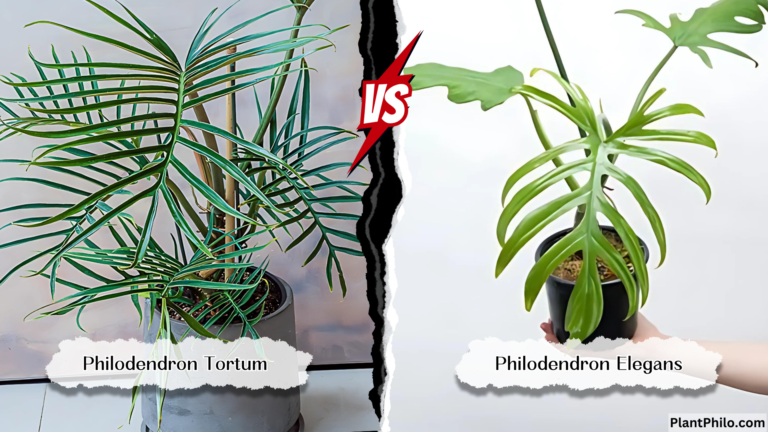Philo Radiatum Vs Mayoi: Don’t Get Catfished by Your Philodendron
Think all philodendrons are created equal? Think again! Radiatum and Mayoi, these leafy lookalikes, are pulling a fast one on plant parents everywhere. Don’t fall for their foliage flimflam! Get ready to decode their secret language, from stem to petiole, and finally know which one deserves a spot in your green haven.
Philodendron Radiatum is also known as Split-Leaf Philodendron because of its big lobed leaves that look like they have been cut in half.
On the other hand, Philodendron Mayoi has bushier growth with deeply lobed leaves and reddish petioles, which gives it away easily from other varieties. Once you learn these variations, it will be easier for you to understand what makes each of them special.
| Feature | Philodendron Radiatum | Philodendron Mayoi |
| Leaf Shape | Shallow or deep lobes, heart-shaped base | Deep, consistent lobes with pointy tips |
| Leaf Size | 8-12 inches (up to 18) | 8-12 inches |
| Leaf Texture | Smooth, sometimes glossy | Smooth, glossy, sometimes bullate between veins |
| Petiole | Green, sometimes reddish | Deep red or burgundy |
| Stem Color | Green, sometimes pale brown | Green, often reddish in younger plants |
| Growth Habit | Vining, faster-growing | Compact, bushier |
| Soil | Well-draining aroid mix | Well-draining aroid mix |
| Temperature | 65°F-85°F (18°C-29°C) | 65°F-85°F (18°C-29°C) |
| Humidity | Moderate to high (50-70%) | High (60-80%) |
| pH Level | 5.0-7.0 | 5.0-7.0 |
| Rarity & Price | Common, affordable | Rare, can be expensive |
| Other Notes | More tolerant of fluctuating conditions | Prefers consistent care, sensitive to overwatering |
No matter if you need a climbing plant to fill vertical space or a compact, bushy companion – this part should be useful for you too. Leaf shape & color, stem & petiole characteristics – all these details are listed here in order to help people take good care of any kind of philodendrons they decide on.
Key Takeaways
- Mayoi has a more compact appearance than Radiatum, with pronounced reddish petioles, whereas the latter one has large deep lobes on its leaves.
- Both types require bright indirect light and should be watered when the top inch (2 cm) of soil dries out completely.
- Petiole coloration and depth of leaf lobing might assist in identifying your plant type correctly.
Taxonomic Breakdown
Philodendron radiatum x mayoi is an easily confused pair among houseplants within the same genus called Philoden-drons however there exist a number features which make them different from one another especially growth habit and leaf structure .
Philodendron Radiatum
Radiatum belongs to Mexico up north Colombia where it thrives in various settings. The leaves of this species are either shallowly or deeply lobed and can also be triangular in shape with a heart-shaped base that has further segmented lobes at the bottom. Its mid-rib is usually thicker than most other philodendrons hence acting as one of its key identifiers.
Under favorable conditions, Radiatum can grow up to six feet tall, creating quite an amazing centerpiece for any room. Unlike Mayoi, which is relatively slow-growing, Radiatum tends to add lushness faster due to its accelerated growth rate. The stems may be greenish or pale brown, while petioles could range from greenish-red coloration depending on lighting conditions.
Philodendron Mayoi
Mayoi is not common within the Philodendron genus as compared to other members found there although it still boasts some unique features too. The leaves of Mayoi species tend to have deeper pointy tips than those belonging to Radiatum which are more consistent and rounded. Furthermore, these red-colored stalks stand out against green stems/leaves making them easily noticeable (especially when viewed from a distance).
Philodendron Mayoi rarely exceeds three feet tall at maturity, thus being ideal for smaller rooms where space may be limited.
It likes keeping the soil evenly moist but does not appreciate overwatering that leads to root rot disease; therefore, ensure drainage holes are available if grown indoors. Watering is frequently required during hot/dry seasons to prevent wilting.
To get more information, you can check this detailed care guide on Philodendron Mayoi.
Delving into the Leaves: A Visual Guide
Peculiarities of the Leaf: Philodendron Radiatum and Mayoi
These two plants have leaves with unique characteristics that distinguish them from other plants. These differences are important in correctly identifying these species.
Shape
A heart-shaped or oval form when they are young is common for Philodendron Radiatum leaves. In time, such leaves grow lobes that are well marked; these lobes may be deeply or shallowly cut and pointed at the tips or rounded instead.
Philodendron Mayoi, however, has deeper lobes with consistently more acute points than any other philodendron species – this makes its leaf structure differentiating feature (singular).
Color
Leaves of both Philodendron Radiatum and Philodendron Mayoi are without patterns – just solid green throughout. Sometimes they can glisten a little bit giving an impression of healthiness and liveliness even more so.
Solid greenness unvariegated by color is common to both species but not necessarily helpful for telling them apart, although it does add beauty to their appearance.
Size
The size of these plants’ leaves can get really big. In optimal conditions, a leaf on either Philodendron Radiatum or Mayoi may reach 8-12 inches long.
Large proportions create lushness that is associated with tropics hence making them suitable for indoor gardening where space might be limited.
Venation
Another characteristic feature shared between these two types of philodendrons lies within their venations. In such a way as to appear lighter yellowish-green against a darker background, some veins run across the whole leaf blade while others do not go beyond certain areas called “veinlets” or even “sinusoids”.
This pattern looks beautiful, providing texture to otherwise smooth surfaces, which would have been boring were it not for this intricate network connecting all parts together into one whole.
Examining the Stems and Petioles
Stem and petiole (the stalk that holds the leaf to a stem) are characteristics of Philodendron Radiatum or Mayoi plants that can help you determine which plant you have.
Stalks
Radiatum stems are green, sometimes slightly brown. They tend to be thin but can grow quite long if provided with support; these stems also have air roots for climbing trees or other structures.
On the other hand, younger Mayoi plants usually have reddish stems – this may not always be the case though. The stem is often thicker than that of Radiatum plant type. Both support and nourish the growth of any given species albeit there being only slight variations in colouration between them which could aid identification purposes.
Leaf-stalks
The leaf-stalk called petiole differs significantly in appearance from one philodendron to another; thus, it is no different when comparing Radiatum’s with Mayoi’s petioles.
Usually green but sometimes slightly reddish like the stem coloration above them, Philodendron radiatum’s petioles bear much resemblance to their stem counterparts; these latter structures help hold up leaves while allowing nutrient flow between them through vascular tissues embedded within each part.
In contrast, deep red or burgundy-colored leaf stalks differentiate Philodendron major plants from other varieties, such as radiators, where this feature might not exist at all (singular).
By looking at these features closely, you will be able to know more about your philodendrons’ needs so as you can take better care of them. You can learn more about these differences by visiting GardenHyper and Plantophiles websites.
Growth Habit and Care Requirements
Both philodendrons require specific conditions for optimum growth rates; therefore, fostering environments suitable for each variety becomes necessary, i.e., knowing how they grow best according to their light preferences, watering frequency, etc.
Growth Pattern
Philo Radiatum is generally faster than Philo Mayoi, growing up to 6 feet tall, while the latter stays smaller at about 2-3 feet. It’s a climbing plant that uses aerial roots to cling onto supports such as moss poles or trellises, which makes it ideal for them. In contrast, Mayoi grows more compact and bushy since it doesn’t climb.
Light
Both species like bright indirect light and do well under filtered sunlight, similar to what is found under a tree canopy. However, they should not be placed in strong direct rays because this can cause scorching of leaves. If natural light is inadequate during winter when days are shorter, consider supplementing with grow lights.
Watering
Water once the top inch of soil is dry, but ensure that you never let the ground become too wet over time, as this could result in root rot. Both Philo Radiatum and Mayoi prefer their soil kept evenly moist but not waterlogged; hence, using pots with drainage holes would help prevent water from stagnating at the bottom.
Soil
For both types, a well-draining aroid mix is recommended which should consist of orchid bark, perlite and peat moss among other components for adequate aeration and drainage.
Such composition imitates their native environment where roots can receive enough air while retaining sufficient moisture around them therefore heavy potting soils that hold too much water should be avoided.
Additional Notes
Temperature & Humidity: They thrive best between 65°F (18°C) -85°F (29°C). Protect from cold drafts and sudden drops in temperature, which might stress them out.
Pruning & Propagation: Regular pruning helps keep shape as well encouraging new growth; stem cuttings with nodes can be used for propagation too.Radiatum needs support since it climbs whereas bushy growth of mayoi does not require it.
Identification: Cracking the Code
In this section we will go through some distinguishing features of Philodendron Radiatum and Philodendron Mayoi such as petiole color, leaf lobe development, stem color.
Petiole Color
When trying to tell these plants apart, pay attention to the stalk attaching a leaf to the stem (petiole). Philo mayoi usually has deeper red or burgundy colored petioles which is quite different from philo radiatum that generally has greener ones with just slight reddish tinge.
For easier identification, consider:
- Philo Mayoi: Deeper red or burgundy petiole
- Philo Radiatum: Greener with a less noticeable reddish hint on its’ petioles
Leaf Lobe Development
Another important characteristic is how lobed their leaves are. Typically, philodendrons may have deeper lobes that are more pointed throughout. In fact, these lobes tend to be sharper, making the whole leaf look segmented.
On the other hand, philodendron radiatum can have shallower lobes where some might even not point at all hence giving them an inconsistent appearance. It’s also good noting that younger leaves of both plants may exhibit lesser degrees of lobe development so check older ones for better identification.
Key points to remember:
- Philo Mayoi: Deep, consistently pointed lobes
- Philo Radiatum: Shallow lobes with variable pointedness
Stem Color
Lastly examine stem colour which could help you narrow down your options between different species. Although both can have green or slightly brown stems; sometimes younger ones in particular of mayoi show subtle reddish hue.
On the other hand, Philodendron Radiatum’s stems are generally green with occasional appearances of brown.
Important points to remember about stem color:
- Philodendron Mayoi: Young stems can sometimes have a slightly reddish hue
- Philodendron Radiatum: Green or slightly brown stems
Frequently Asked Questions
Here are answers to some common questions about telling apart and taking care of Philodendron Radiatum vs. Mayoi:
What are the distinguishing features between Philodendron Mayoi and Radiatum?
Philodendron Radiatum can grow up to 6 feet tall while Philodendron Mayoi usually stays smaller at around 2-3 feet. Mayoi is a rare species with unique characteristics among them being that it climbs.
How can I differentiate Philodendron Mayoi from Radiatum based on their leaves?
When young, Philodendron Radiatums may have heart-shaped or oval leaves, which later develop lobes as they grow older; these lobes can either be deep or shallow. Conversely, Philodendrons Mɑyοi generally possess deeper and more uniformly pointed lobes.
What are the care requirements for Philodendron Mayoi compared to those of Radiatum?
For instance, while Μayοi needs frequent watering but should not be left sitting in waterlogged soil, thus necessitating proper drainage systems, Ρhίlοdеndrοn Radіаtum should also be planted in well-draining soil mixtures and placed under bright indirect light just like Μayoі.
Can both varieties thrive under similar environmental conditions?
Yes, both plants can do well in comparable habitats. They all require bright indirect light since direct sunlight could scorch their leaves; additionally, the two need aeration of soil around their roots, which can only be achieved if such soil drains water fast enough.
Describe the growth habits of Philodendron Mayoi versus Radiatum
Radiatum grows much faster and can reach up to 6 feet, while Mayoi is a climber and viner, usually not exceeding 2-3 feet. Both plants may benefit from support structures such as moss poles or trellises.
What about the differences in root systems between Philodendron Mayoi and Radiatum?
Both species thrive best when grown on well-drained soils; hence it would be important for you to ensure that your soil drains excess water easily. The roots of these plants are quite similar thus there seems to be no significant difference between them but still avoid overwatering which leads to root rot.
Feel free to dive deeper into each plant’s attributes so you can make an informed decision on which one will work best for your indoor garden!

